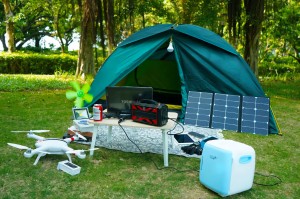
The energy storage industry is in the midst of a highly prosperous cycle.
On the primary market, energy storage projects are being snapped up, with many angel round projects valued at hundreds of millions of dollars; on the secondary market, since the low point of the market in April this year, there are few listed energy storage companies whose share prices have doubled or tripled, with P/E ratios of over 100 times becoming the norm.
Whenever there is a popular track outbreak, there are inevitably other players jumping out in various ways to "dabble in the track" to reap capital dividends, and the energy storage track is naturally no exception. The recent landing on the Growth Enterprise Market (GEM) of Huabao New Energy has played a vague "rubbing the ball".
The main business of Huabao New Energy is portable energy storage, which is also called "large rechargeable treasure". According to the prospectus, it ranks first in the world in terms of shipments and sales of portable energy storage products in 2020, with a market share of 21%.
Household energy storage refers to large household energy storage devices with a capacity of 3 degrees or more.
Portable energy storage devices, also known as "large rechargeable batteries" and "outdoor power supplies". Strictly speaking, it is a small energy storage product, just like mobile phone batteries and ordinary rechargeable batteries. However, it is not the same "species" as residential energy storage, and there are significant differences between the two product categories, application scenarios and business models.
The capacity of portable energy storage is generally in the range of 1000-3000Wh, which means that it can store 1-3 degrees of electricity and can only be used for 1.5 hours by an induction cooker with a power of about 2000W. It is mainly used for outdoor activities such as camping, photography, fishing and other emergency scenarios such as earthquakes and fires.
Household energy storage refers to large household energy storage devices with a capacity of 3 degrees or more, mainly used for off-grid household self-generation, electricity storage backup and peak-to-valley tariff arbitrage.
The business models for portable and domestic energy storage are significantly different due to the different product categories.
Portable energy storage is cheaper and more consumer electronics, so it can be sold more easily through e-commerce; however, household energy storage is not only more expensive, but also requires higher safety requirements, so it needs the cooperation of local distributors and installers, which requires the relevant manufacturers to carry out the layout of offline channels.
There are significant differences between portable energy storage and domestic energy storage.
In almost all business models, the industry track is the first step and it is the basis for all subsequent realisations. What track a company is in usually determines the ceiling height of the business. In terms of downstream markets, there is a significant difference in market size between portable energy storage and domestic energy storage.
As mentioned earlier, portable energy storage is mainly used in outdoor activities and emergency scenarios, so its main consumer market is located in the United States, Japan and Europe, with scattered and niche consumer groups, especially in the United States, where the penetration rate of outdoor activities is high, occupying nearly half of the market share.
The development of household energy storage is mainly due to the support of national government subsidies, as well as high electricity prices (peak-to-valley arbitrage) economic improvement, especially in the European market, due to rising electricity prices year by year, the Russian-Ukrainian war, the impact of the energy crisis, this year's household energy storage market to achieve a more than expected outbreak.
The development of the portable energy storage market, on the other hand, will always have to face the problem of niche demand. Its future market space will mainly come from the demand for outdoor sports and lightweight emergency disaster preparedness.
Due to more rigid demand and a wider range of applications, the market size for household energy storage is also going to be larger.
However, there are also institutions that believe that portable energy storage will always be a limited size of the "niche market", not keen on outdoor sports in the country for portable energy storage demand will have been very limited.
Although the development of the outdoor market in many countries is still in its infancy, such as China's participation in outdoor activities in the proportion of the population is only 9.5%, much lower than the United States of about 50%, it seems to have a lot of room for improvement, but the lifestyle of domestic residents may not be able to evolve as much as the European and American markets.
In addition, the rapid explosion of portable energy storage in the last two years is largely due to the growth in demand for outdoor activities under the epidemic - self-driving trips, camping, picnics, photography, etc. As the epidemic subsides, it is doubtful that this demand will continue.
Household energy storage has a larger charge and higher requirements for safety. Its household energy storage system has certain technical thresholds in components such as electric cores, PCS and power modules. Want to cut into this track, both in technology, or channel construction, the difficulty is not small.
Post time: Sep-19-2022